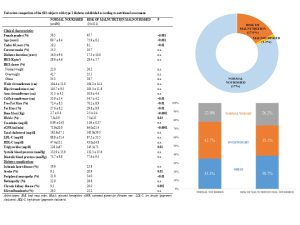Introduction: The nutritional status of diabetes subjects is often underestimated and few data are available linking malnutrition to the onset of diabetes-related complications. Aim: To evaluate the relation between nutritional status and body composition with the development of T2D vascular complications. Methods: Cross-sectional study including 601 outpatients with T2D. We assessed the following data: demographic, diabetes-related (duration and control, vascular complications), biochemical (lipids, creatinine), and anthropometrical (body circumferences and bio-impedance analysis). The mini nutritional assessment (MNA) questionnaire allowed us to classify the recruited subjects as normal-nourished (NN), at risk of malnutrition (RoM) or mal-nourished (MN). Univariate and multivariate analyses were performed to identify the association between diabetes complications and nutritional status (NN group vs RoM+MN group). Results: 81.4% of T2D subjects were NM, while 17.0% and 1.3% were at RoM or MN, respectively. The univariate analysis showed, in RoM+MN vs NN group, a significantly higher percentage of female gender (65.7% vs 38.3%), mean age (73.9±8.2 vs 69.7±8.4 years) and glycated haemoglobin (HbA1c) (7.5±1.0% vs 7.3±0.9% years) at recruitment, while the two groups were similar for body mass index (BMI), and body circumferences, except for the calf circumference, lower in RoM+MN (p=0.002) (Tab.). The body composition evaluation showed that RoM+MN vs NN group had a significantly higher fat mass (29.8±8.9% vs 27.6±8.2%) and lower free-fat mass (70.2±8.9% vs 72.4±8.3%). No difference in diabetes drugs was observed. The multivariate model, considering, age, gender, diabetes duration, HbA1c, and smoking habit, showed a significant association between abnormal nutritional status and stroke occurrence (HR 2.7; 95%CI 1.46-4.98; p=0.001). Conclusions: These data showed the importance of investigating the nutritional status in T2D, regardless of BMI and age, considering the high prevalence of malnutrition and its possible relation with vascular diabetes-related complications.


